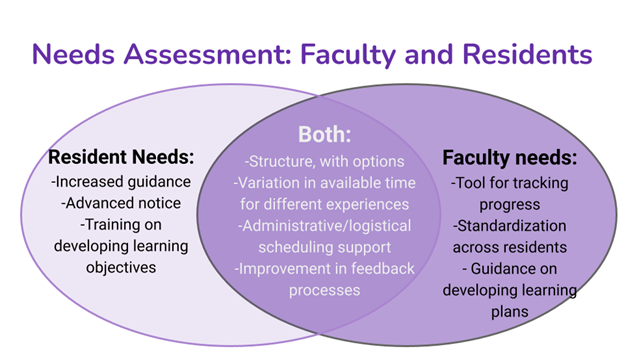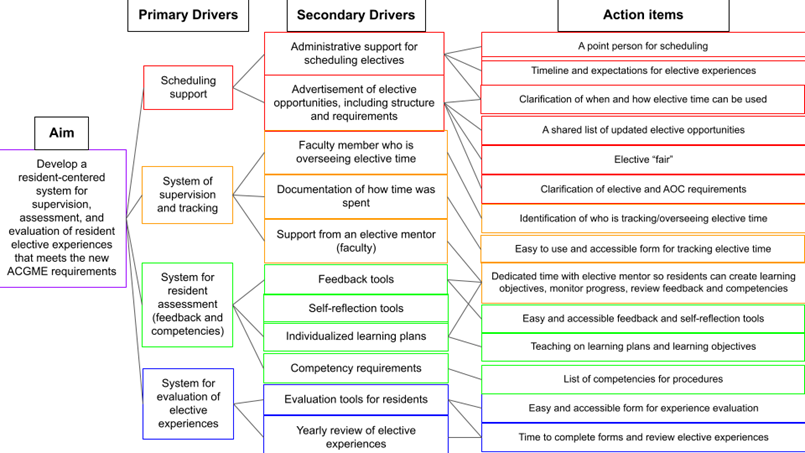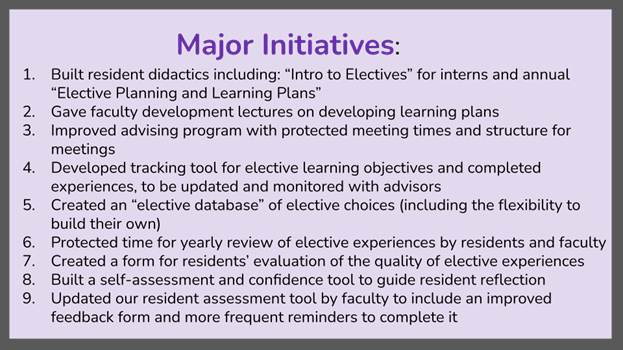Other Publications
Education Columns
Elective Planning 101: How to Help Residents "Choose Their Own Adventure" to Meet New ACGME Elective Requirements
By Shaylagh Cerulli, MD, MMedEd; Jessica Early, MD; Randi Sokol, MD, MPH, MMedEd; Omar Wahid, MD; Lopez Davis, MD; Efthalia Kaynor, MD; Emily Marbas, MD; Allen Shaughnessy, PharmD, MMedEd; Tufts University Family Medicine at Cambridge Health Alliance, Tufts University School of Medicine, Boston, MA
Background
New ACGME requirements require 600 hours of curriculum time for electives, a significant portion of a resident’s training.1 Additionally, programs must show that residents have developed tailored learning objectives and there are systems in place for rotation evaluation and resident feedback during elective time, mirroring the model of competency-based education.2 Individual programs have to build these systems to help residents identify elective experiences and monitor progress toward their goals. Our program performed a year-long project with the goal of building an elective curriculum to meet the new requirements and the needs of our individual learners. During this time, we assessed the needs of our residents and faculty, performed a literature review of best practices, developed a driver diagram to organize the action items required to achieve our aim, and began implementing initiatives. With our new curriculum, residents have support in creating their own self-directed learning outcomes and learning plans to meet the new ACGME requirements and “choose their own adventure” to develop skills in lifelong learning.
Intervention
Our team of residents and faculty started our needs assessment with a careful review of the ACGME requirement and an analysis of our current elective structure. We additionally administered surveys to faculty and residents to assess what was liked and disliked about our current elective structure and how comfortable people were with developing learning objectives and plans (Figure 1).
After identifying these gaps in our elective structure, our team developed a driver diagram, a tool for quality improvement projects to organize the action items required to achieve an aim.3 From our overall aim, we identified four topic areas that were essential to achieving this aim– scheduling support, a system of supervision and tracking, a system for resident assessment and feedback, and a system for evaluation of elective experiences. We broke these down into secondary drivers, or smaller components of the primary drivers.3 We created our list of action items, or specific ideas that needed to be in place to reach the aim (Figure 2).3 Major initiatives included faculty development on creating individualized learning plans, building an elective database, structured resident advising sessions, and structured formats for resident assessment and rotation evaluation (Figure 3).
Figure 1: Needs assessment outcomes

Figure 2: Driver diagram on for elective curriculum

Figure 3: Major initiatives in the first year

Conclusions and Recommendations
We used a process of curriculum development that resulted in identifying a process for residents to “choose their own adventure” by supporting them in developing their learning plans and selecting or creating experiences to meet their learning goals. Both the process we used and the major initiatives we instituted can be used by other residencies to improve the resident and faculty experience with electives. Balancing structure with flexibility of elective time is an issue we identified that takes continued attention to meet residents’ needs.
Based on a survey and in-person group discussion, we found that residents were using more of their elective time for elective work, most residents had completed the required parts of the process including submitting learning objectives and participating in advising meetings, and faculty felt improved confidence with elective structures. Next steps include focusing on resident assessment.
The new elective program from the ACGME is an opportunity to transition away from telling residents what to do and move toward self-directed learning so that residents have the skills to create and reach new learning goals long after graduation. The skills and knowledge acquired through the process of “choosing their own adventure” might aid residents in developing and maintaining a habit of lifelong learning throughout their careers.
References
1. Accreditation Council for Graduate Medical Education. Family Medicine. https://www.acgme.org/specialties/family-medicine/overview/. Accessed July 18, 2024.
2. Newton WP, Magill M, Barr ., et al. . Implementing competency based ABFM board eligibility.J Am Board Fam Med 2023; jabfm.2023.230201R0: DOI: https://doi.org/10.3122/jabfm.2023.230201R0
3. Picarillo AP. Introduction to quality improvement tools for the clinician. J Perinatol. 2018 Jul;38(7):929-935. doi: 10.1038/s41372-018-0100-4.
